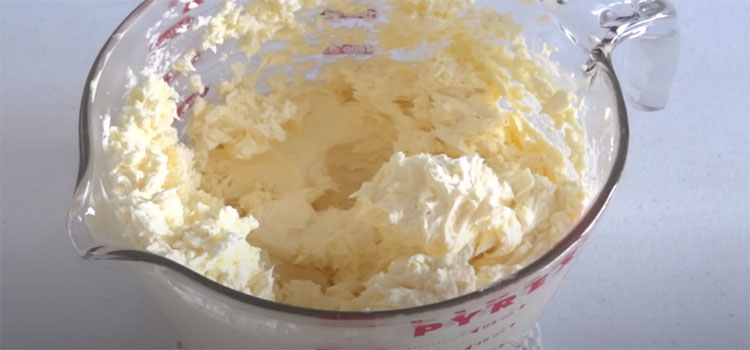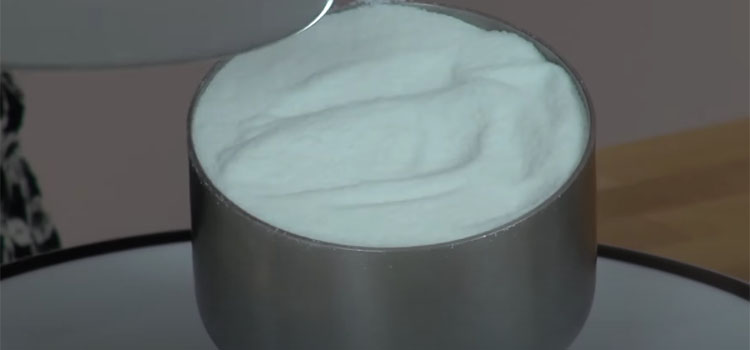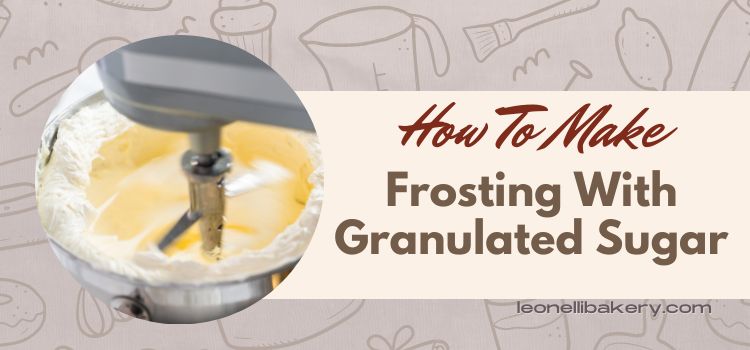Last Updated on July 22, 2024 by Lori Walker
Granulated sugar, when incorporated into icing, transforms into a charming and airy coating ideal for enhancing baked goodies such as cakes, cupcakes, and cookies.
The first time I gave it a shot, my kitchen was filled with the delightful aroma of sugar, and the frosting turned out incredibly smooth and delicious.
Today, I’ll share how to make frosting with granulated sugar, perfect for adding sweetness to your favorite treats.
Easy Guide For Making Frosting With Granulated Sugar

Ingredients
- 1/4 cup of butter
- 1/2 cup of granulated sugar
- 1/2 cup of cream
Recipe Instructions:
- Gathering Your Ingredients: To start making frosting with granulated sugar, gather your key ingredients. You’ll need a quarter cup of butter [1] and 1/2 cup of granulated sugar. Having these measured and ready ensures a smooth and efficient process as you create your sweet frosting.
- Blending the Butter and Sugar: It’s time to combine the butter and sugar. Blend them together using a mixer or a sturdy spatula until the mixture becomes smooth. This step is crucial to ensure the sugar dissolves into the butter, creating a creamy foundation for your frosting.
- Add Cream: Once you’ve achieved a smooth blend of butter and sugar, it’s time to introduce cream into the mix. Add 1/2 cup of cream to your mixture. The cream will bring richness and creaminess to your frosting, enhancing its flavor and texture.
- Continuing the Blending Process: With the cream added, continue blending the mixture. The goal here is to create a completely smooth and creamy frosting. This might take a few minutes, but the patience will pay off as your frosting becomes delectably velvety.
- Ready to Use for Delicious Treats: Now that your frosting is perfectly smooth and creamy, it’s ready to use. This homemade delight can elevate various desserts, from cookies to small treats, for any occasion. Your efforts in following these simple steps will result in a sweet and irresistible frosting to enhance your culinary creations.
Also Read: Simple Tips To Make Sugar Cookies Without Baking Powder
Is It Okay To Use Granulated Sugar In Cakes?
Using granulated sugar in cakes is perfectly fine and is the most commonly used sugar in baking.
Granulated sugar is versatile and can provide the sweetness your cakes need while contributing to their structure.
“Sugar does make people happy, but then you fall off the edge after a few minutes, so I’ve really pretty much cut it out of my diet. Except for cupcakes. I like those.”
– David Lynch, American Filmmaker
The flavor and water content are similar to other sugars used in baking, so it won’t drastically alter your cake’s taste or texture.
Granulated sugar can work wonders whether you’re making a classic sponge cake or a rich chocolate cake.
But how will you dissolve granulated sugar in frosting?
What’s The Ratio Of Granulated Sugar To Make 1 Cup Of Powdered Sugar?

If you’re substituting granulated sugar for powdered sugar, a common guideline is to use 1 cup of granulated sugar for every 1 3/4 cups of powdered sugar.
However, it’s best to rely on weight rather than volume for a more precise and straightforward conversion.
When using a recipe that calls for 1 cup of powdered sugar, about 4 ounces or 113 grams, substitute it with an equivalent weight of granulated sugar, which is also 4 ounces.
This weight-based approach ensures accurate results in your baking endeavors, making achieving the desired sweetness and texture in your frostings and recipes easier.
Check out these simple steps to make vanilla sugar using extract here.
How Does Confectioners Sugar Differ From Granulated Sugar?
Confectioners’ sugar, also known as powdered sugar, stands out due to its ultra-fine texture, created by crushing it into a powdery form [2].
This fine consistency dissolves quickly, perfect for smooth and lump-free frostings, glazes, and dessert dusting.
“Whipping up frosting with granulated sugar is a sweet science that turns ordinary ingredients into extraordinary treats.”
– Leonelli Bakery
In contrast, granulated sugar, often called white or regular sugar, has a coarser texture with distinct grains.
It’s commonly used in baking to provide sweetness, structure, and texture to various recipes.
FAQs
What is the best sugar for frosting?
The best sugar for frosting is powdered sugar. It’s exceptionally fine, making it the top choice for creating smooth, velvety cake icing.
Its fine texture ensures that your frosting will be lump-free and evenly blended, resulting in a delectably sweet and creamy topping for your cakes and desserts.
Can granulated sugar be a substitute for powdered sugar in whipped cream?
Yes, you can use granulated sugar as a substitute for powdered sugar in whipped cream, but there are better choices.
Powdered sugar is preferred for sweetened whipped cream because it contains a small amount of starch that helps the cream maintain its texture and stability for a longer period, resulting in a fluffier topping.
How can you turn granulated sugar into powdered sugar without a blender?
If you don’t have a blender, you can still turn granulated sugar into powdered sugar. Try using a coffee grinder, spice grinder, or mortar and pestle.
Grind it for 1–2 minutes until it becomes a fine white powder. After grinding, sift it through a fine-mesh strainer to remove any remaining large granules.
What can be substituted for powdered sugar in icing?
Several substitutes for powdered sugar in icing include dry milk powder, powdered monkfruit sweetener, and powdered coconut sugar.
These alternatives can provide sweetness and a smooth texture similar to powdered sugar, making them suitable options for various icing recipes.
In Summary
Ultimately, creating frosting with granulated sugar is a delightful endeavor that can add a sweet touch to your baked creations.
Using granulated sugar in cakes is acceptable, with a recommended ratio of 1 cup granulated sugar to 1 3/4 cups powdered sugar.
However, for precision, using an equal weight of granulated sugar as powdered sugar is even more accurate.
Furthermore, understanding the difference between confectioners’ sugar and granulated sugar is crucial.
Confectioners’ sugar, finely powdered, is ideal for creating smooth, lump-free frostings and glazes. In contrast, with its coarser texture, granulated sugar serves as a staple in baking, providing structure and sweetness.
References:
- https://www.realsimple.com/health/nutrition-diet/butter-nutrition
- https://www.thespruceeats.com/what-is-confectioners-sugar-995626
- How to Store Krispy Kreme Donuts To Keep Them Fresh Longer - July 23, 2024
- How to Make Frosting with Granulated Sugar: A Simple Guide - July 22, 2024
- What Happens to Bakery Waste? - July 22, 2024
